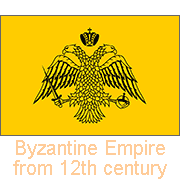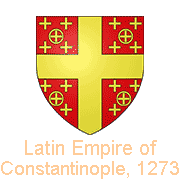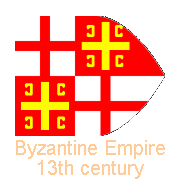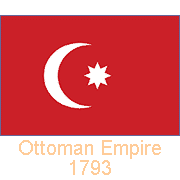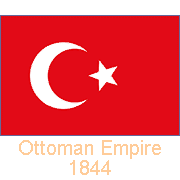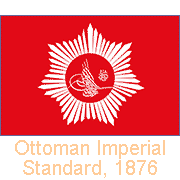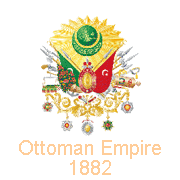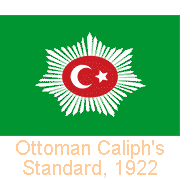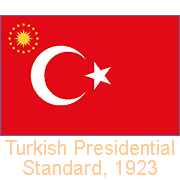Flags from Turkey
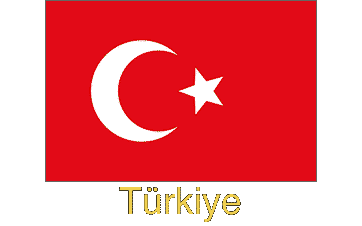
A Flag history of Turkey
Constantine I (Constantine the Great) established the Eastern Roman Empire in the Greek settlement of Byzantium in 324 CE, henceforth named Constantinople, the present İstanbul. Known as the Byzantine Empire, its symbol had become a double-headed eagle. This symbol dated back to the 12th Century and was introduced by the emperors of the Komnenos dynasty. It was based on superstition from Cappadocia about a gigantic eagle with two heads that would steal livestock and kill its owners. Later a sword (“Romfaia”) and the Globe of Orthodoxy were added and the crown by the Palaiologos dynasty. The Greek Orthodox Church, retaining its Byzantine culture, still uses this flag. The double-headed eagle symbol has been used on flags in many European countries, past and present.
you may then send it as a postcard if you wish.
In the 13th Century, symbols appeared in the Byzantine Empire, featuring the Victory Cross. It is associated with Emperor Constantine the Great who had a vision sent by the Christian God promising victory at the Battle of the Milvian Bridge in 312 CE. It appeared on the Arms of the Latin Empire of Constantinople, a feudal Crusader state, established after crusaders had seized lands from the Byzantine Empire in 1204. The Byzantine Empire was re-established by Michael VIII Palaiologos who had recaptured it from the Latin Empire of Constantinople. The arms of the Palaiologos family displayed the Cross of Victory with four firesteels, carbon steel pieces used in fire-making, an old Byzantine/Orthodox symbol.
During the history of the Ottoman Empire, a variety of flags were used, especially as naval ensigns, displayed on ships. These often featured a crescent moon, often with a star, on a green flag. The star and crescent were Byzantine symbols, known from coins dating back to the 1st Century BCE. The logo is much older: it was known as far back as the 4th Century BCE in the iconography of the Hellenistic period in Asia Minor. The Ottomans adopted the Crescent and Star symbol after the conquest of Constantinople, in1453. The green flag was associated with Islam and became the flag for the Ottoman Caliphate, founded in 1517.
On land the horse-tail standard or tuğ (tugh) was first used, rather than flags, reflecting the origin of the Turkish peoples in Central Asia, going back to the Mongol Empire. War flags came in use from the 16th Century onwards and often depicted the bifurcated Zulfiqar sword. In 1793 the green flag of the Ottoman Empire was changed from green to red by decree, during the reign of the reform-minded Sultan Selim III, who ruled from 1789 to 1807. The flag featured an eight-pointed star, but this officially became a five-pointed star in 1844. This flag remained virtually unchanged until today and was standardised in 1936.
A Coat of Arms was adopted by the Ottoman Empire in 1882, during the rule of Sultan Hamid II; it featured the “tuğrâ”, his calligraphic monogram, seal or signature, in the green shield at the top. The tuğrâ was also displayed on the Imperial Standard. The last Caliph, Abdülmecid II (1922–1924) also had a Standard, a green flag with a white star and crescent on a red oval background within a rayed ornament. Atatürk abolished the Ottoman Caliphate in 1924.
A year earlier he had proclaimed the Republic of Turkey and a Presidential Standard was adopted. It displayed, on the National Flag, the Presidential Seal in the Upper hoist. The Seal, on a red background, featured a large 16-pointed Sun, symbolising the Republic of Turkey, surrounded by 16 five-pointed stars, signifying the 16 Great Turkish Empires in history. It is the oldest Presidential Seal in the world still in use.


